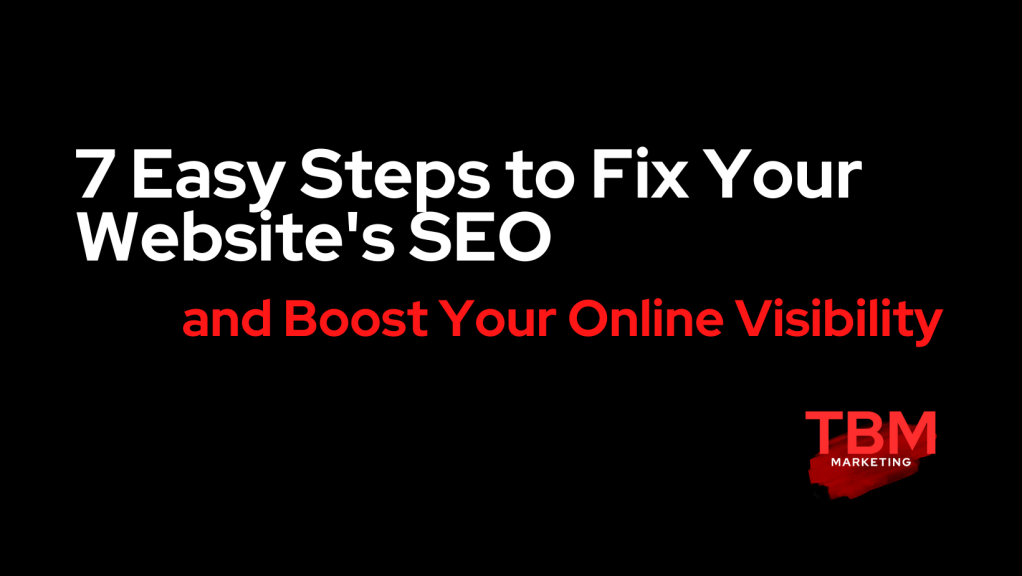Search Engine Optimization (SEO) is the backbone of online visibility, ensuring that your website ranks well in search engine results. However, many website owners struggle to understand and implement effective SEO strategies. If your website isn’t getting the traffic it deserves, it might be time to give your SEO a tune-up.
Here are seven easy steps to help you fix the SEO on your website and enhance your online presence.
- Keyword Research: Start by identifying relevant keywords and phrases that your target audience is likely to use when searching for products or services related to your website. Tools like Google Keyword Planner or SEMrush can help you discover high-traffic keywords with manageable competition. Incorporate these keywords naturally into your website’s content, including titles, headings, meta descriptions, and body text.
- Optimize On-Page Elements: Ensure that your website’s on-page elements are optimized for search engines. This includes optimizing title tags, meta descriptions, heading tags (H1, H2, H3), and image alt attributes. Make sure each page has a unique title tag and meta description that accurately describe the content. Use relevant keywords in these elements to improve their visibility in search results.
- Create High-Quality Content: Content is king in the world of SEO. Create engaging, informative, and relevant content that addresses the needs and interests of your target audience. Regularly update your website with fresh content, such as blog posts, articles, videos, infographics, and other multimedia formats. Quality content not only attracts visitors but also encourages other websites to link back to yours, improving your site’s authority and search engine ranking.
- Improve Website Speed: Website speed is a crucial ranking factor for search engines like Google. A slow-loading website not only frustrates visitors but also receives lower rankings in search results. Use tools like Google PageSpeed Insights or GTmetrix to analyze your website’s loading speed and identify areas for improvement. Optimize images, enable browser caching, minify CSS and JavaScript files, and consider using a content delivery network (CDN) to improve your website’s performance.
- Mobile-Friendly Design: With the increasing use of mobile devices, having a mobile-friendly website is essential for SEO success. Ensure that your website is responsive and displays correctly on various screen sizes and devices. Google prioritizes mobile-friendly websites in its search results, so optimizing your site for mobile users can significantly boost your search engine rankings.
- Optimize for Local Search: If your business serves a specific geographic area, optimizing your website for local search is crucial. Create a Google My Business listing and ensure that your business name, address, and phone number (NAP) are consistent across all online directories and platforms. Encourage satisfied customers to leave positive reviews, as they can significantly impact your local search rankings.
- Monitor and Analyze Performance: Regularly monitor your website’s performance using tools like Google Analytics and Google Search Console. Track key metrics such as organic traffic, bounce rate, click-through rate (CTR), and keyword rankings. Analyze this data to identify areas for improvement and adjust your SEO strategies accordingly. Continuously optimize your website based on performance insights to maintain and improve your search engine rankings over time.
By following these seven easy steps, you can fix the SEO on your website and enhance your online visibility. Remember that SEO is an ongoing process that requires patience, consistency, and adaptation to changing algorithms and trends. With dedication and effort, you can improve your website’s SEO and attract more organic traffic, ultimately boosting your online success.
What happens when you don’t take care of your SEO
Having poor SEO negatively affects your Google rankings for several reasons. Firstly, your website becomes less visible to search engines like Google when its SEO is lacking. Search engines use complex algorithms to determine which websites are most relevant to a user’s query. If your website isn’t optimized for these algorithms, it’s less likely to appear in search results, resulting in lower visibility.
Moreover, SEO involves using relevant keywords and phrases that users are likely to search for. If your website lacks optimized content with these keywords, it won’t rank well for related searches. Google assesses the relevance of your content to user queries, so poor SEO means your website might not match the search intent of users, leading to lower rankings.
Search engines prioritize websites that provide a positive user experience. Factors such as page loading speed, mobile-friendliness, and ease of navigation all contribute to the overall user experience. If your website has poor SEO, it may suffer from issues like slow loading times, broken links, or a lack of mobile optimization, resulting in a negative user experience and lower rankings.
Furthermore, high-quality backlinks from reputable websites are essential for building authority and trustworthiness in the eyes of search engines. Poor SEO may result in fewer backlinks, or worse, links from low-quality or spammy websites. This can signal to search engines that your website lacks credibility, leading to lower rankings.
Lastly, the online landscape is highly competitive, with countless websites vying for attention. Websites with strong SEO are more likely to outrank competitors in search results. If your website has poor SEO, it’s at a disadvantage compared to competitors with better-optimized content, leading to lower rankings and decreased visibility.
Overall, poor SEO directly impacts your Google rankings by reducing visibility, relevance, user experience, authority, and competitiveness. By improving your website’s SEO, you can enhance its chances of ranking well in search results and attracting organic traffic.
Follow for more and subscribe to receive for free the Seven-Days Advanced Business Course
Upgrade Your Business in Seven Days: Marketing & Branding Pro Course
Clear Value Proposition – Part 1 and 2
Market Research and Target Audience
Effective Digital Marketing and Customer Acquisition
Solid Business Model
Adaptability and Continuous Innovation
BONUS: Surprise gift!
Receive one subject of the course a day during seven days, straight to your inbox!



Leave a comment